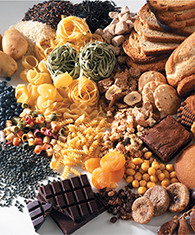Quick Lab
Distinguishing Sugars From Starches
Materials
1 slice each of potato, ripe apple, and bread; 15 mL cornstarch; 15 mL table sugar; iodine in dropper bottle; 6 small paper plates
Procedure
Place one sample of each food on a paper plate. CAUTION Never eat anything in a lab.
Place 2 to 3 drops of iodine solution on the cornstarch. Record your observations.
Repeat Step 2 using sugar instead of cornstarch.
Place 2 to 3 drops of iodine on each of the other food samples. Record your observations.
Analyze and Conclude
Classifying How can an iodine solution be used to distinguish a sugar from a starch?
Drawing Conclusions Which of the food samples contained starch?
Predicting What other foods would turn dark when tested with iodine solution?
Natural Polymers
Almost all of the large molecules produced by organisms are polymers.  Four types of polymers produced in plant and animal cells are starches, cellulose, nucleic acids, and proteins.
Four types of polymers produced in plant and animal cells are starches, cellulose, nucleic acids, and proteins.
Figure 15 All the foods shown contain starch, which is a polymer of the simple sugar glucose. Observing Identify foods that you recognize in the photograph.

Starches
Many animals are attracted to sweet-tasting foods. The compounds responsible for this sweetness are often sugars. Simple sugars have the formula C6H12O6. They can exist as straight chains or rings. The simple sugars glucose and fructose can react to form sucrose (table sugar). Glucose monomers join to form starches as shown below.

Typically, a starch contains hundreds of glucose monomers. Plants store starches for food and to build stems, seeds, and roots. Flour for the bread, pasta, and tortillas shown in Figure 15 is made by grinding the seeds of grains, such as wheat and corn. Simple sugars, slightly more complex sugars such as sucrose, and polymers built from sugar monomers are all classified as carbohydrates.
Cellulose
The carbohydrate cellulose is the main component of cotton and wood. It is the most abundant of all organic compounds found in nature. Cellulose molecules contain 3000 or more glucose monomers. Cellulose gives strength to plant stems and tree trunks. Most animals cannot digest cellulose.




